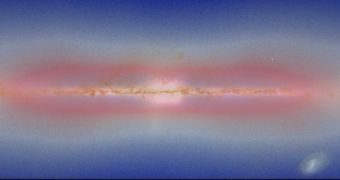Astronomers searching for our galaxy's hypothesized dark matter disk say that they have thus far come up empty-handed in their quest. The features should exist at the locations analyzed if dark matter theories are correct.
Though no clear studies have demonstrated the existence of dark matter directly, astronomers know it's there from the effects it has on normal matter. It is widely believed that the elusive stuff allowed for the development of the earliest galaxies.
After the Big Bang, all galaxies were small, similar in size to the dwarf galaxies we see today. Dark matter is believed to have offered a gravitational scaffolding for them to come together, and form far larger structures, such as the Milky Way.
Over time, galaxies grew to such impressive sizes that they could easily gobble up smaller space structures, and engulf their dark matter as well. According to theories, that dark matter should have been deposited in flat structures, especially around spiral galaxies.
These formations would resemble average disks and halos. However, when trying to detect such a structure around the Milky Way, researchers come up empty-handed. There is nothing there to detect.
Generally, dark matter studies are conducted by investigating the luminous, normal matter it contains. This is the same approach that was first used to detect the existence of the stuff.
Researchers then proceed to analyze the kinematics of the luminous matter, so that astrophysicists can then calculate the amount of mass that would be needed to dictate those motions.
The difference between the observed mass and what is theoretically necessary should be accounted for by dark matter, the thinking goes.
The team that conducted the research focused its attention on some 300 red giant stars, located in the Milky Way's outer disk. They used these bodies to determine whether extra mass existed beyond their orbits, as one would expect if dark matter were accumulated there.
What was peculiar in the new investigation was the fact that the “agreement between the visible mass and our dynamical solution is striking, and there is no need to invoke any dark component,” the authors write.
This means that the gravitational pull of normal matter in the Milky Way is enough to account for the motions of these stars. The research team was headed by C. Moni Bidin, an expert in the Department of Astronomy at the Universidad de Concepcion, in Chile.
The study, called No Evidence for a Dark Matter Disk Within 4 kpc from the Galactic Plane, appears in the online scientific journal arXiv.
Researchers from the European Southern Observatory, the Yale University and Universidad de Chile were also involved in the investigation, Universe Today reports.

 14 DAY TRIAL //
14 DAY TRIAL //